His refuge from disease was Jeju’s beauty
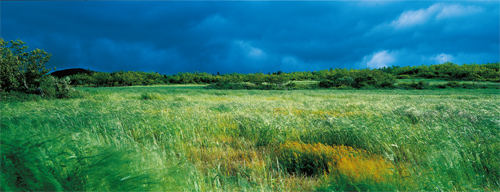
Kim was fascinated by the storms and violent weather that frequently buffet Jeju’s shores, as this photograph by him reflects. Provided by Dumoak
But even today, Kim is remembered as an artist - a photographer who wandered alone through the hills of Jeju Island, in search of beautiful subjects.
In his last few years on earth, Kim transformed a shuttered school on Jeju into a photo gallery and wrote a book of essays. The gallery, Dumoak, is still open, and has now become a tourist attraction.
Dumoak is actually the old name of Mount Halla, South Korea’s highest mountain, located on the island. Kim rented out the site in the village of Samdal-ri, Seongsan-eup, just after his diagnosis in 2001.
It was a grand project, but he couldn’t see it through to completion. When he died in 2005, it was left to his dear friend Park Hun-il, 41, whom he had taught photography, to realize Kim’s dream. Today, Park continues to run the gallery.
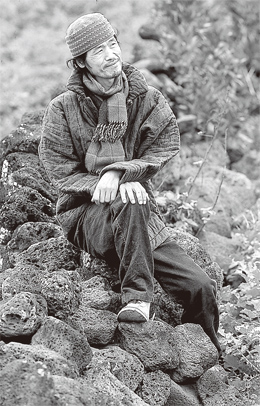
This photo shows Kim Young-gap in winter 2003. He died of Lou Gehrig’s disease one and a half years later. By Kwen Hyek-jae
Contributing to its popularity, three “olle” trail routes pass Dumoak. In Jeju dialect, the word olle refers to the narrow paths that would connect the street to the front gate of the house. Today, it refers to the island’s network of hiking routes, which attracts an increasing number of visitors.
“Among all the olle routes, which stretch 300 kilometers in total, those that pass Dumoak are the only ones that require a toll to use,” said Seo Myeong-suk, the chief director of the Jeju Olle Corporation-Foundation.
Yet crowds still come, to see the natural beauty of the place and the legacy left behind by one of its most ardent devotees.
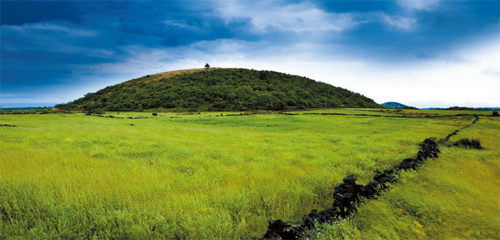
This photo shows a small oreum near a bigger one called Darangsi, which means squirrel in the Jeju dialect. It was one of Kim’s favorite subjects. By Kwen Hyek-jae
Falling in love
Kim’s artistic world can be divided largely into two periods. In the early days, the photographer focused on Jeju’s cultural heritage, including its diving fisherwomen and gut exorcisms. In the 1990s, however, Kim began to be drawn toward the natural landscape. The first place to catch his eye was Mara Island, just south of Jeju. Next he chronicled the sea surrounding the island - but Kim wasn’t interested in the calm blue waters most tourists are greeted with. What intrigued him were the storms that assault the island, bringing rain, snow, wind and sleet.
The uniquely shaped hills of Jeju, called “oreum” in the local dialect, were also an object of interest for Kim. He particularly loved Yongnuni Oreum, so named because it resembles the shape of a dragon laying down. Kim’s friends said what caught his attention was the fact that the oreum looked so completely different depending on one’s point of view.
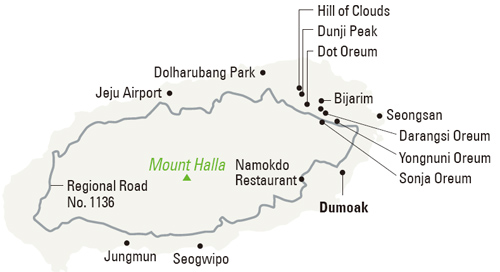
The exhibit currently taking place at Dumoak includes a number of photos of pine trees standing on both sides of a low hill. That geographical feature is known as the “Hill of Clouds,” and is located about eight kilometers from Yongnuni Oreum. Darangsi and Sonja Oreum, all clustered in the mountainous regions in the eastern part of Jeju, also recur in Kim’s works.
A legacy of friendships
To commemorate the beloved photographer, on the fifth anniversary of his death, May 29, a “gallery concert” was held in the courtyard of Dumoak, at which the soprano Park Hyun-ju and tenor Hyun Haeng-bok joined the Jeju Provincial Symphony Orchestra.
At the same event a new song called, “Mr. Kim Young-gap,” with music by Kim In-gap and words by Yang In-ja, sung by Lee Mun-seok, was performed for the first time.
Two books about the artist have also been published. The first, simply titled, “Kim Young-gap,” was written together by 20 people who still remember him. It contains 69 previously unpublished photographs by Kim, as well as stories about Kim and Dumoak told by Kim’s friends, including the poet Lee Saeng-jin, songwriter Yang In-ja, attorney Cha Byung-jik and singer Lee Dong-won.
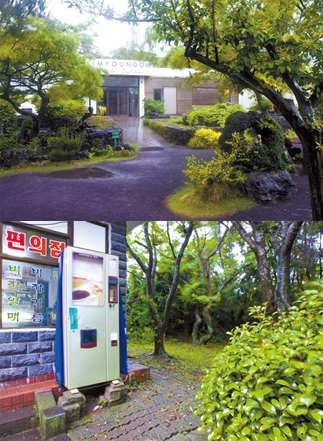
Top: Kim called the cups of instant coffee from this vending machine at the entrance to Bijarim forest on Jeju the “best coffee in the world.” Above: The front gate to Dumoak, the gallery Kim Young-gap founded. By Kwen Hyek-jae
The other book, titled “Love in the Woods,” is a book of illustrated poems, using Kim’s photos as a setting for poems written by Lee Saeng-jin. It is a revised edition of a book originally published in 1997. The photos featured in the book will be on display at Dumoak until June 29.
Kim has left his mark on both people and places on the island. He used to stop for a cup of instant coffee at a particular vending machine near the entrance to the Bijarim woods. The photographer called it “the best coffee in the world,” though that of course probably had as much to do with the incredible surroundings as with the taste. The vending machine is still there, at a convenience store at the trailhead.
Elsewhere, in Bukchon-ri, Jocheon-eup, is Dolharbang Park, which features harubang, or “stone grandfathers,” the statues made of igneous rock from Jeju’s volcanic past. The park was established in 2005 by Kim Nam-
heung, 43, also a friend of the late artist.
In fact, a number of stone sculptures found in the garden at Dumoak were made by Kim Nam-heung. The harubang pieces in his own park are considered some of the best representations of harubang in the region and the country.
“Kim, who worked so hard despite his disease to establish the gallery, was an inspiration for me to found this,” Kim Nam-heung recalled.
They say the best way to get to know a person is to ask his friends. If the same is true of places, then Jeju tourists owe it to themselves to learn about Kim Young-gap, surely one of Jeju’s most faithful friends.
Admission to Dumoak is 3,000 won ($2.50). For more information, call (064) 784-9907 or visit www.dumoak.co.kr. Admission to Dolharbang Park is 4,000 won. For more information, call (064) 782-0570 or visit www.dolharbangpark.com.
By Son Min-ho [spark0320@joongang.co.kr]
김영갑, 그 떠난 지 5년, 제주엔 여전히 바람 분다
비가 한두 방울 떨어지기 시작했다. 제주공항에서 차를 몰아 한라산 기슭을 넘는 길. 하늘이 잔뜩 찌푸린 채 내려와 있었다.
“서울은 맑았는데. 이놈의 제주 날씨….” 혼자 투덜거리자 옆자리 권혁재 사진전문기자가 심드렁하게 내뱉는다.
“영갑 행님 보러 올 때 언제 날 좋은 적 있었나? 영갑 행님이 다 알아서 할 기라.”
정말 그랬다. week&이 김영갑과 처음 인연을 맺은 2003년에도 비가 내렸다. 2003년 12월 12일 week&은 ‘사람이 희망이다’란 제목의 커버 스토리를 내보냈다. 거기에서 week&은 루게릭 병에 걸린 제주 사진작가 김영갑의 사연을 처음 보도했다. 그때 김영갑은, 병원이 내린 시한부 판정을 2년 더 넘겨 살고 있었다. 그것도 모자라 그는 폐교를 사진 갤러리로 바꾸는 공사를 벌인 참이었다. 두 발로 걷기는커녕 손도 마음대로 올리지 못해 엎드려 죽을 핥아먹던 47㎏의 희귀병 사진쟁이가 삶을 붙들고 있는 모습에 독자 반응이 쏟아졌다. 기사가 나간 뒤 바로 출간된 김영갑 에세이 『그 섬에 내가 있었네』가 베스트셀러에 올랐고, 갤러리에 사람이 몰려들었다.
김영갑이란 사내가 있었다. 제주 중산간을 홀로 헤매 다니며 사진을 찍다 온몸의 근육이 마르는 병에 걸려 세상과 이별했다. 사내가 떠나고 나서야 세상은 그가 남긴 사진을, 아픈 육신 이끌고 일군 갤러리를 알아본다. 김영갑이 남긴 사진 중에서.
두어 달쯤 뒤 갤러리를 찾았을 때 김영갑은 “덕분에 갤러리 공사를 마무리할 수 있게 됐다”고 말했다. 그 뒤로 김영갑은 형님이 됐고, 제주에 내려갈 때마다 갤러리를 들렀다. 몸이 많이 좋아졌다던 형님은 그러나 2005년 5월 29일 아침 다시는 일어나지 않았다.
갤러리에서 박훈일(41) 관장과 함께 중산간 지역으로 출발했다. 박 관장은 형님을 “삼촌”이라고 부른다. 김영갑이 제주에 막 내려왔을 때 형님은 박 관장 집에서 몇 해를 살았다. 그 인연으로 박 관장은 형님을 따라다니며 사진을 배웠고, 형님이 훌쩍 가버리자 주인 잃은 갤러리를 떠맡았다. 형님이 떠나고서 5년 사이, 갤러리는 명소가 됐고 박 관장은 폭삭 늙었다.
용눈이오름에 올랐다. 빗줄기가 거세졌다. 등산화 안까지 빗물이 차올랐고 모진 바람에 얹힌 비가 옆에서 따귀를 때렸다. 그래도 K선배는 카메라 셔터를 연방 눌러댔다. 이튿날도 호된 비바람과 싸우며 온종일 중산간을 헤맸다. 저녁 뉴스를 보니 그날 제주 산간지역은 호우 경보 상태였다. 한나절 만에 600㎜가 넘는 폭우가 퍼부었다.
5주기만 아니었어도 이토록 미련하게 작업하진 않았을 것이다. 제사상에 술 한 잔 올리지 못한 못난 동생들의 성의라고 생각해주면 좋겠다는 마음이었다. 사실 김영갑이 남긴 20만 장의 제주 풍경 중에서 맑은 하늘은 많지 않다. 권선배의 말마따나 형님은 자신이 어떤 환경에서 사진을 찍었는지 동생들에게 가르쳐주고 싶었는지 모른다.
이번으로 김영갑 기사를 7번째 쓴다. 그중에서 5번이 고(故) 김영갑(1957~2005)으로 시작한다. 그게 가장 아프다.










with the Korea JoongAng Daily
To write comments, please log in to one of the accounts.
Standards Board Policy (0/250자)